

|
Soundclips - Lead Sheet & Solo:
| Live in Berlin:
|
| See Steve's Hand-Written Solo
Transcription |
|
Steve Khan's solo on: "Careful!"(Jim Hall) Though I have probably told parts of this story before, I am feeling inspired to go at it again, perhaps from a different angle, perhaps with a bit more wisdom? When I moved to New York in January of 1970, I thought that I was arriving ready to play, ready to be an artist and to pursue my dream of becoming a great Jazz guitarist and musician. I arrived only knowing two people: David Friedman(vibes) and John Miller(ac./el. bass). It didn't take too long to realize that upon arrival, I was NOT the musician that I had thought that I was - or, better said, that I hoped that I was. David Friedman, who is one of the greatest musicians that I have ever had the privilege to know and work with quickly recognized my shortcomings, and, in a quiet moment, suggested that I go and take some lessons from the great Jim Hall. 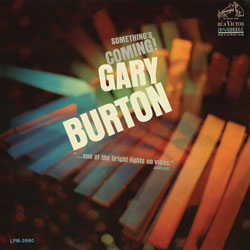 And so, as I knew that David was right, I phoned Jim, made an appointment, and began my studies. This was already some 7-8 years after Jim had recorded some of his greatest and most memorable albums as a sideman. I'm speaking of his recordings with both Paul Desmond and Sonny Rollins. But, it shouldn't be lost on everyone that, in August of 1963, he had also recorded the album "SOMETHING'S COMING" with a young vibraphonist, Gary Burton. Also appearing on this album were Steve Swallow(acoustic bass) and Larry Bunker(drums). On this very album appears the Jim Hall original blues titled: "Careful!." I've added in the exclamation point because, when I wrote out this tune and brought in to Jim for one of my lessons, he added in the exclamation point to accentuate that this was a 16-bar blues and NOT the traditional 12-bar blues, and the players had to be careful not to get lost! And so, as I knew that David was right, I phoned Jim, made an appointment, and began my studies. This was already some 7-8 years after Jim had recorded some of his greatest and most memorable albums as a sideman. I'm speaking of his recordings with both Paul Desmond and Sonny Rollins. But, it shouldn't be lost on everyone that, in August of 1963, he had also recorded the album "SOMETHING'S COMING" with a young vibraphonist, Gary Burton. Also appearing on this album were Steve Swallow(acoustic bass) and Larry Bunker(drums). On this very album appears the Jim Hall original blues titled: "Careful!." I've added in the exclamation point because, when I wrote out this tune and brought in to Jim for one of my lessons, he added in the exclamation point to accentuate that this was a 16-bar blues and NOT the traditional 12-bar blues, and the players had to be careful not to get lost!When I arrived in New York, I brought with me my 4 music notebooks that I had filled with my transcriptions of various songs, standards and Jazz standards by all the greats - a bit guitar-centric, but useful nonetheless. You have to remember that, in 1970, there was no such thing as a "REAL BOOK"! Yes, there were some primitive Fake Books floating around. but they were in the underground and were not always the most accurate, especially when it came to the "real" chord changes. What I didn't realize was that, in other parts of this great country, other musicians of a similar leaning to me were also arriving here, and they had brought with them their own huge notebooks filled with the same transcriptions, and more!!! I quickly saw that I should have been concentrating even more on the great pianists, saxophonists, and trumpeters. Between all of us, there was always a great exchange of information, and I traveled around the city with music paper and pencils tucked away, always ready to write something down, and add to my bounty of tunes. It wasn't long before I had filled 7 notebooks with all of these materials that would become the cornerstone of my self-education. When I arrived at Jim Hall's apartment downtown on W. 12th St., I was greeted by Jim's wife Jane, and Jim and I were seated across from one another at the kitchen table, a very small one. Over the course of my studies with Jim, he added some tunes with his chord changes that he wanted me to study. Those tunes included obvious favorites of his, "All the Things You Are" and "Body and Soul." He also wanted me to purchase the Bach "SONATAS and PARTITAS" for violin. I didn't understand what this could possibly have to do with what I had come there seeking from Jim. In all honesty, it wasn't until years later that it came to me what he had been trying to do for me. 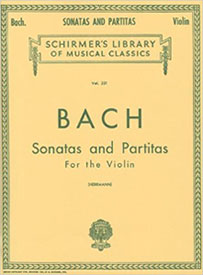 Sometimes, we can come to study with someone, and, in truth, we are not ready to learn what they are trying to share with us. That was the case for me. Jim would assign me one of the partitas, and I would faithfully work very hard at it, and come in the next week ready to play it. After listening to me, he would always say something like this: "Steve, that's fine, but I want you to play this piece like YOU, interpret it as you would - not so much being completely faithful to Bach's intention." As I just wrote, I could not grasp what he was saying and only years later did I get it. Better late than never!!! Sometimes, we can come to study with someone, and, in truth, we are not ready to learn what they are trying to share with us. That was the case for me. Jim would assign me one of the partitas, and I would faithfully work very hard at it, and come in the next week ready to play it. After listening to me, he would always say something like this: "Steve, that's fine, but I want you to play this piece like YOU, interpret it as you would - not so much being completely faithful to Bach's intention." As I just wrote, I could not grasp what he was saying and only years later did I get it. Better late than never!!!Eventually, I discontinued my studies with Jim, because I didn't feel that I was getting what I needed from him. It was not his fault, again, I just wasn't ready to be his student! That was the problem. I am, as I have been, a most inquisitive student, and there were specific mannerisms, techniques to Jim's playing that I desperately wanted to know - specific to the guitar. So sometimes, when we were playing duo, and I was comping for him, he would play something, and I would stop! He looked at me quizzically, and a bit upset when I asked him: "What was THAT that you just played?" He would almost always respond by saying, "What was WHAT?!?!?!" After this happened more than a few times, I realized that I was going to have to figure those things out for myself, Jim wasn't going to just hand them to me. I became frustrated by this. It is now ironic that some of these very mannerisms or techniques actually appear within the melody statement of "Careful!" and during his brief 2-chorus solo. I will point them out as they appear. This, I promise you!!! At this point, I think that it is important to discuss the melody statement of the piece. Here you have the opportunity to hear two very precise players playing a melody in unison, but because of the presence of Jim Hall, he gives it a feeling of being interpreted more than just stated. In other words, it's fine to have precision, but a sense of swing and looseness can outweigh those concerns. Something to think about! One of the first things that you might notice about this performance is that it is just 4:11 in length, and that the melody is only stated once, and Jim only plays 2 solo choruses. In the years of the LP, producers wanted to keep the time per side down to around 18-minutes, because this was the limit with vinyl for getting the hottest pressing - meaning, the most level or volume. In those days, this was desirable for the radio. Out in front of the melody, drummer Larry Bunker on brushes plays a 4-bar Intro. Then, Gary and Jim state the first 3 bars of the melody alone, as a duo, before Larry rejoins them at the hit on the and-of-4 of bar 3, and then Steve Swallow walks them into bar 5 and the D7 chord. One of Jim Hall's technical traits that influenced so many players of my generation and beyond was his "elimination of picked strokes." There is no better example of this than the ascending 16th-notes that you see in bars 2 and 10. What is so appealing about this is that, if one picked each of those notes, it is likely to feel much more stiff, and have less swing to it! Try such things yourself and see how you end-up feeling about it. The phrasing of the melody in bar 14 is especially particular to Jazz and to Jim grafting on to the guitar the phrasing of horns and the piano. Again, executing such small details can seem so simple, but usually, unless someone shows you how it is best done, you can struggle with these details forever! From a purely linear perspective, this blues puts to use the scale degree of the b9 more than most would. Some might see this as a most cerebral gesture, but, it appeals to my sensibilities, and it always has. However, I choose to see those notes, Bb over the A7 chord and Eb over the D7 chord more as upper neighbors to the root than purely as a b9. I would imagine that, one of the things that must have driven recording engineers completely nuts was Jim's constant futzing with his volume control knob. Of course, this probably came from years of trying to harness the amplifier feedback associated with hollowbody Jazz guitars like the Gibson ES-175. If you ever saw Jim play live, you would have noticed this for sure - but, you can even see this in countless YouTube videos that are readily available. 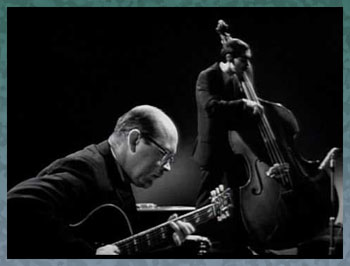 In this very same light, this same volume control madness makes a transcriber's job really difficult at times. You hear him doing this during this relatively short solo. I tried my best to really listen inside of the track to better determine what happened at those moments and I have notated, in some instances, my best educated guess, even though it's a bit indistinct - especially considering that Jim was panned hard right - which can make things easier. So, with this kept in mind, let us begin..... In this very same light, this same volume control madness makes a transcriber's job really difficult at times. You hear him doing this during this relatively short solo. I tried my best to really listen inside of the track to better determine what happened at those moments and I have notated, in some instances, my best educated guess, even though it's a bit indistinct - especially considering that Jim was panned hard right - which can make things easier. So, with this kept in mind, let us begin.....On the downbeat of Chorus 1 of the solo, there is just such a moment, and if I didn't know Jim's playing so well, I might have written down something else, but, I could barely hear that he played the 'guide tones' for A7 (G-C#) before moving to single-note lines. Though I tried to write out this solo using 8th-note subdivisions, it became complex. So, at the top of the page you see an indication that the tune is played with a 'swing' feel which should automatically indicate to the player that two 8th-notes are felt like the front and back end of an 8th-note triplet. Normally, I would never write such a thing, because players just know it! Jim begins the solo true to his nature, and that is to take elements from the melody and allow those same elements to become thematic devices for the solo as well. Pay attention to how he works in that previously discussed upper-neighbor Bb(b9) into the opening phrases. With the arrival of bar 5 and the IV7 chord, D7, Hall turns more bluesy, which is nice to see/hear, because, often times, to many, Jim is not thought of as a particularly bluesy player. But, on beat 4 of bar 5 with the inclusion of that Ab, a blue note, he's right there!!! Bar 6 sees the return of more Jazz phrasing mannerisms, take note of the groupings of triplet 16th-notes attached to an 8th-note. These are crucial if you want to sound and feel like a Jazz player. Also, listen for the Eb at the end of bar 6, which again recalls that upper-neighbor to the root, in this case Eb to D-natural. At the end of bar 8, the last 5 8th-notes [D-F-D-E-D] are barely audible, but they're there!!! With the return of A7 in bar 9, Jim is dancing around very basic chord tones, but in bar 11, that Bb upper-neighbor returns to decorate the phrase and tie it together with the melody and the beginning of the solo. As he heads towards bar 13 and the arrival of the F7(9b5) chord, he uses an arpeggio in triplets that outlines A7(9sus), but the last note, an F-natural, anticipates the coming chord. In bar 13, you have all scale tones or modal tones as you would expect to see notes from C melodic minor [C, D, Eb, F, G, A, B]. Over the E7 chord in bar 14, Jim is mixing his modal choices, because he touches upon both C#(the natural 13th) and C-natural, the #5 - but then, you also have Bb(b5) and A-natural(the 4th)-G-E. I view the latter 3 notes as being more apart of the blues language heading back to A7. He lands on an Eb(b5) before slip-sliding around to end-up on an E-natural. Bar 16 serves as a pick-up to the 2nd chorus, where again, I feel that Jim is in a much bluesier frame of reference as he 'rides a note' - in this case the root, A-natural for most of the 1st 4 bars. Deciding how I was going to write out the phrasing of the 1st 5 bars of Chorus 2 was tricky for me, but, the only reasonable choice was to write it out using 16th-note subdivisions. What makes it all the more subtle is that Jim is also playing behind the beat, more laid-back, to accentuate the bluesiness of the feeling he's conveying. 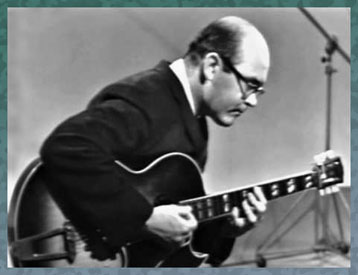 Pay special attention to the slippery-slidey phrase on the last 2 beats of bar 4. This is so very Jim Hall, beautifully articulated to perfection as he lands on the 3rd(F#) of D7 on beat 1 of bar 5. Bars 7-8, Hall is ascending using a sequence using D Mixolydian [D, E, F#, G, A, B, C] as key landing points beginning on an A-natural on beat 2 of bar 7. Those modal tones are sometimes preceded by a whole-step and sometimes by a half-step. Eb to D, on beat 1 of bar 8 is still, to these ears, tied to our melody. In bar 9, with the return of our I7 chord, A7, Jim draws from his lexicon of slickly articulated phrases, notice beat 4. Phrases such as this one seem so effortless, as they should, but they do require great, yet subtle, technique - that being an upwards or backwards sweep. it's not so easily done! You might want to pay attention to the 1st beat of bar 10 too, as he uses an Ab as the chromatic upper-neighbor to G-natural. The chord that I hear him playing on beat 3 of that bar is barely audible again - but I am fairly certain that I hear and Em7(9sus) chord - spelling up: G-D-F#-A. In bar 11, that darn Bb-A interval returns and harkens back to his melody, while in bar 12, the A-G-A-G is again bluesy to these ears. In this final chorus, over bars 13-14, Jim keeps things very, very simple with the emphasis falling on the roots of each chord: F7 to E7. He cadences into bar 15 accentuating the root, A-natural, of A7. The solo finishes with a final decorative flourish of 4 little descending sweeps, each beginning with a double-stop: G-C; E-A; C-E; and G-C. Jim makes it sound so easy - but trust me, it's not. Just try it yourself. When you get the left-hand figured out, then those little sweeps becomes really tricky!!! The final resolution of this great, and all too brief, solo finds Jim landing on an Eb(b5) on beat 1 of what will begin Gary Burton's series of choruses. Pay special attention to the slippery-slidey phrase on the last 2 beats of bar 4. This is so very Jim Hall, beautifully articulated to perfection as he lands on the 3rd(F#) of D7 on beat 1 of bar 5. Bars 7-8, Hall is ascending using a sequence using D Mixolydian [D, E, F#, G, A, B, C] as key landing points beginning on an A-natural on beat 2 of bar 7. Those modal tones are sometimes preceded by a whole-step and sometimes by a half-step. Eb to D, on beat 1 of bar 8 is still, to these ears, tied to our melody. In bar 9, with the return of our I7 chord, A7, Jim draws from his lexicon of slickly articulated phrases, notice beat 4. Phrases such as this one seem so effortless, as they should, but they do require great, yet subtle, technique - that being an upwards or backwards sweep. it's not so easily done! You might want to pay attention to the 1st beat of bar 10 too, as he uses an Ab as the chromatic upper-neighbor to G-natural. The chord that I hear him playing on beat 3 of that bar is barely audible again - but I am fairly certain that I hear and Em7(9sus) chord - spelling up: G-D-F#-A. In bar 11, that darn Bb-A interval returns and harkens back to his melody, while in bar 12, the A-G-A-G is again bluesy to these ears. In this final chorus, over bars 13-14, Jim keeps things very, very simple with the emphasis falling on the roots of each chord: F7 to E7. He cadences into bar 15 accentuating the root, A-natural, of A7. The solo finishes with a final decorative flourish of 4 little descending sweeps, each beginning with a double-stop: G-C; E-A; C-E; and G-C. Jim makes it sound so easy - but trust me, it's not. Just try it yourself. When you get the left-hand figured out, then those little sweeps becomes really tricky!!! The final resolution of this great, and all too brief, solo finds Jim landing on an Eb(b5) on beat 1 of what will begin Gary Burton's series of choruses.I can't recall exactly how I came to own and retain an LP of Jim Hall's appearance and performance of "Careful!" on an LP titled "BERLIN FESTIVAL - GUITAR WORKSHOP" which was recorded on November 5th, 1967, but I remember reading that the album was supposed to have included the performances of Larry Coryell with the Gary Burton Quartet, one of the most important groups that helped to light the path for coming Fusion Era. 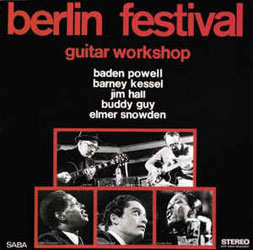 As it so often happens when 'business' meets music, RCA Records refused to grant permission for Larry's performances to appear on the album for another label, and so the LP was missing the contrast of one of the great modernists of that moment in time. As it so often happens when 'business' meets music, RCA Records refused to grant permission for Larry's performances to appear on the album for another label, and so the LP was missing the contrast of one of the great modernists of that moment in time. However, if you compare and contrast Jim Hall's performance of "Careful!" some 4 years after the original "SOMETHING'S COMING" version, now, in a trio setting with reliable long time colleague Steve Swallow(ac. bass) and Bobby Moses(drums) [both of whom were in Berlin, and appearing at the festival as part of the aforementioned Gary Burton Quartet], you can clearly hear how much more loose and free Jim is, and how his interpretation of his own tune had evolved. If it's possible, it has become ever more Jim Hall than it was before. One of my favorite things about this performance is how Jim has now incorporated the famous french horn call or horn 5ths [that term courtesy of the great and most erudite Rob Mounsey] during the melody statement's repeat in bar 4 at about :53 into the soundclip!!! Check it out! He does it again during his solo too at 2:12. What is so humorous about these inclusions is that this blues is in 'A' and the french horn calls are in the b5 substitute of Eb major to transition to the IV chord of D7!!! The key element to me about this performance is how beautifully Jim is playing behind the time, and with purpose!!! It is a most wonderful element of his style and his great maturity. With the passage of time, if one continues to play a tune, it begins to change, to transform itself, to morph into something else, often times, something deeper. Notice the changes that Jim has made to the phrasing of bar 13 over the F7 chord. And some of the notes have changed too! Gone is the E-natural, replaced by Bb to F. For me this is fascinating. There are other little touches as well. Look at bar 16, before [A2] begins, the little whole-tone lick putting to use his open G and B-strings. It adds further humor and humanity to the piece. Finally, in bar 8, while the D7 chord is still in play, take a look at his usage of the dissonant and quirky double-stops, major 7ths: F-F# to C#-D to B-natural-Bb. You could view the first interval as being connected to D7(altered) as you have F(#9) and F-natural(3rd), but perhaps the C# is best related to as a foreshadowing of the return to A7? You will have to determine this for yourself. On Sunday, July 8th, I spent a wonderful Sunday afternoon with close friend and one of our greatest recording engineers, James Farber, watching the John Abercrombie DVD documentary, "OPEN LAND" which I had recently purchased. What a beautiful and moving experience it was to be able to listen to an old and dear friend, a musical colleague for decades speaking about himself, his life, and his music in a most relaxed and casual setting. 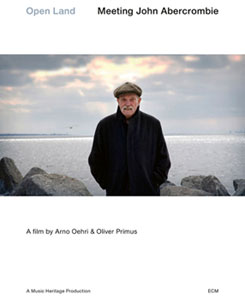 Heard at various times during the film were pieces from his vast catalog including: "Sad Song"; "Within a Song"; "Banshee"; "Lisa"; "Class Trip" and finally, "Timeless." All except the last tune were engineered by James Farber for ECM! John's beautiful playing and music-making on "Within a Song" alongside Joe Lovano reminded me so much of everything that John brought with him to his musical table from Jim Hall. There is almost no better example of Jim's influence than this particular performance. Heard at various times during the film were pieces from his vast catalog including: "Sad Song"; "Within a Song"; "Banshee"; "Lisa"; "Class Trip" and finally, "Timeless." All except the last tune were engineered by James Farber for ECM! John's beautiful playing and music-making on "Within a Song" alongside Joe Lovano reminded me so much of everything that John brought with him to his musical table from Jim Hall. There is almost no better example of Jim's influence than this particular performance.During the film, fantastic reflections were offered by drummer Adam Nussbaum and organist Gary Versace. What they added to the feeling about John and his music was perfect. It was so great to hear them speaking about John with such admiration and affection. And, of course, there was footage of them performing in Europe as well - equally and totally great. There was also a very touching moment towards the end with his wife, Lisa, and I found what she had to say to be so moving and beautiful about John and their relationship, one that spanned some 33 years or more, I can't remember exactly. But, what she expressed was so poignant about a love and understanding of her place and role in his life. It moved me so very much. John also reflects on the fire that took place in 2002, where he lost his house and virtually everything in it. It's remarkable that some photos, or an album of photos survived - and some of those very photos appear in the film - wonderful shots of John as a youth, and photos of his father and those reflections were so great to hear. At one point, James and I were stunned to see a photo of John Scofield, Bill Connors, myself, and John taken for "GUITAR WORLD" magazine in 1984 at John's loft in Chelsea, Manhattan. All four of us lived within a few blocks of one another! It was quite a time! What was so great for me, apart from being a cameo in the documentary, was that I had gotten the photos from Jonathan Postal, and had copies of this photo made for Sco', Bill and John, and framed them as gifts - somehow I don't know what happened to my own copy of that same photo - which has been heartbreaking for me as the years have come and gone. But, James took a photo for me with his trusty iPhone of the frozen TV screen, and now I have it again Towards the end of the documentary, we see John playing some piano, and I was struck in that moment hearing him that, his TOUCH on the piano was EXACTLY the same as his touch on the guitar - LIGHT, EXQUISITE and so BEAUTIFUL, as if he was barely touching the instrument, floating over the keys. For me, it was an amazing moment!!! This documentary stands as a beautiful tribute to a wonderful person, and one of our greatest guitarists and artists!!! I miss you John - very much on this day!!! - Steve
[Photos: Jim Hall & Steve Swallow
Jim Hall] |